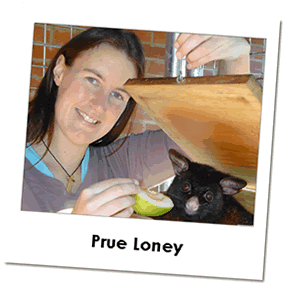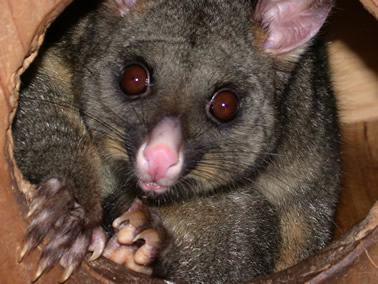
| Home > The Scientists > Prue Loney | |||||||||||||||
Currently Prue is in the final year of her PhD in Plant Science and Zoology, in conjunction with the Cooperative Research Centre for Sustainable Production Forestry. Prue is lucky enough to have an ecological project in that combines her interest in both plants and animals, as her project examines characteristics of eucalypt leaves that may affect browsing by mammalian herbivores.
Her experience studying herbivores provided Prue with an exciting opportunity to do some volunteer work in Africa last year, helping research another herbivore, but much larger and aggressive than the possums and wallabies she was use to – black rhinoceros. “Without my research experience in herbivory, I would not have the opportunity to do this volunteer work,” says Prue. “It was a totally awesome and beneficial experience that I will never forget”. Prue’s science background has also come in useful for her part time work as a bushwalking guide in Tasmania. “My background in botany and zoology has come in handy for providing guests with interesting information, and quirky little facts on Tasmania’s flora and fauna”. Find out more about Prue's research Keywords: Brushtail possums, mammalian herbivores, marsupial browsers, monofluroacetate Browsing by native mammalian herbivores in eucalypt plantations is a major economic problem in plantations in Australia, and throughout Australia the methods used to protect forestry plantations from browsing are fiercely debated both socially and politically, particularly the use of monofluroacetate (1080) in Tasmania.
“My research, and that of the research group I am involved in, focuses on developing non-lethal forms of browsing management” says Prue. “My particular project looks at how I can alter the palatability of eucalypt seedlings to brushtail possums and pademelons, by manipulating the environment eucalypt seedlings are grown in”. Prue manipulates the environment the seedlings are grown in, by adding different amounts of fertiliser to the seedlings. By doing this, the physical and chemical characteristics of the leaves are changed, and therefore so is the attractiveness of the leaves to possums and pademelons.
Useful Websites: For more information and great ideas for classroom activities, visit: School of Zoology School of Plant
Science Forestry CRC
Class discussion
on the management of browsing animals in Tasmania’s forests. As mentioned previously, browsing by native mammalian herbivores in eucalypt plantations is a major economic problem in plantations in Australia, and throughout Australia the methods used to protect forestry plantations from browsing are fiercely debated both socially and politically, particularly the use of monofluroacetate (1080) in Tasmania. For more information
on 1080 in Tasmania there are numerous sites you can visit including: The use of 1080 will be banned in state forests by the end of 2005, and there has been speculation that it will be banned within the next few years in privately owned forests as well. However irrespective to whether 1080 will be banned, it is important to think of alternatives that will be socially acceptable to the public. Ask students why browsers are a problem: In Tasmania
we have three problem browsers: brushtail possums, pademelons, and
Bennett’s wallabies. These browsers can severely limit plantation
establishment by decreasing seedling growth, and even killing seedlings.
Furthermore, if browsers continually eat the tips of seedlings,
we end up with bushes instead of trees. Browsing by these animals can cost the forestry industry millions of dollars. Research has shown that a single possum can destroy more than 200 seedlings in a single night – think what 50 possums on one plantation could do in a night! Sites with high browsing pressure suffer 100% mortality and require re-planting year after year without some form of browsing management. Ask students what methods could be used to manage browsing in forestry in plantations: These can be divided into methods that are lethal or non-lethal to the animals – the ones below are only examples as there are other methods. Lethal Non-lethal Ask students to discuss the advantages and disadvantages of each: Lethal 1. Shooting
Disadvantages:
2. Poison
Disadvantages:
Non-Lethal 1. Fencing
Disadvantages:
2. Tree
Guards
Disadvantages:
3. Cover
Crops Advantages:
Disadvantages:
4. Trapping and Relocating the Browsers Advantages:
Disadvantages:
|
|||||||||||||||


